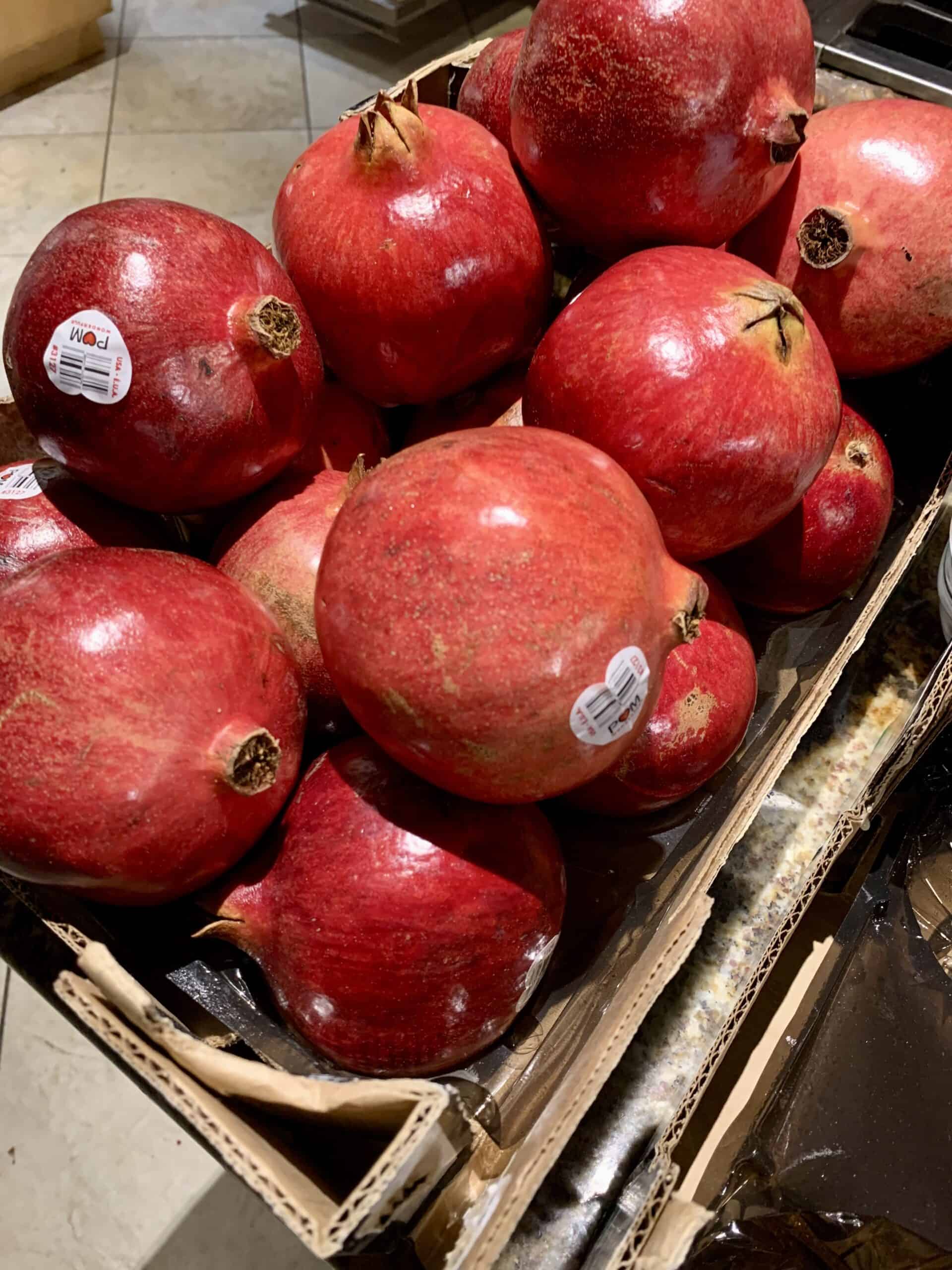Whether you want to buy pomegranates from the grocery store or pick them from a tree, I explain how to tell if a pomegranate is ripe. I also discuss when to buy them so they will be at their best.
If you are reading this in November, December, and January and are buying pomegranates in North America, the pomegranates you see in stores are ripe or possibly overripe. They likely won’t be underripe.
It’s okay if they have some dark lines and markings on them.
You don’t want them to be soft, mushy, or overly hard. Don’t buy them if they are shriveling a bit. These are signs the pomegranates are overripe.
Of course, do not buy them if they are moldy.
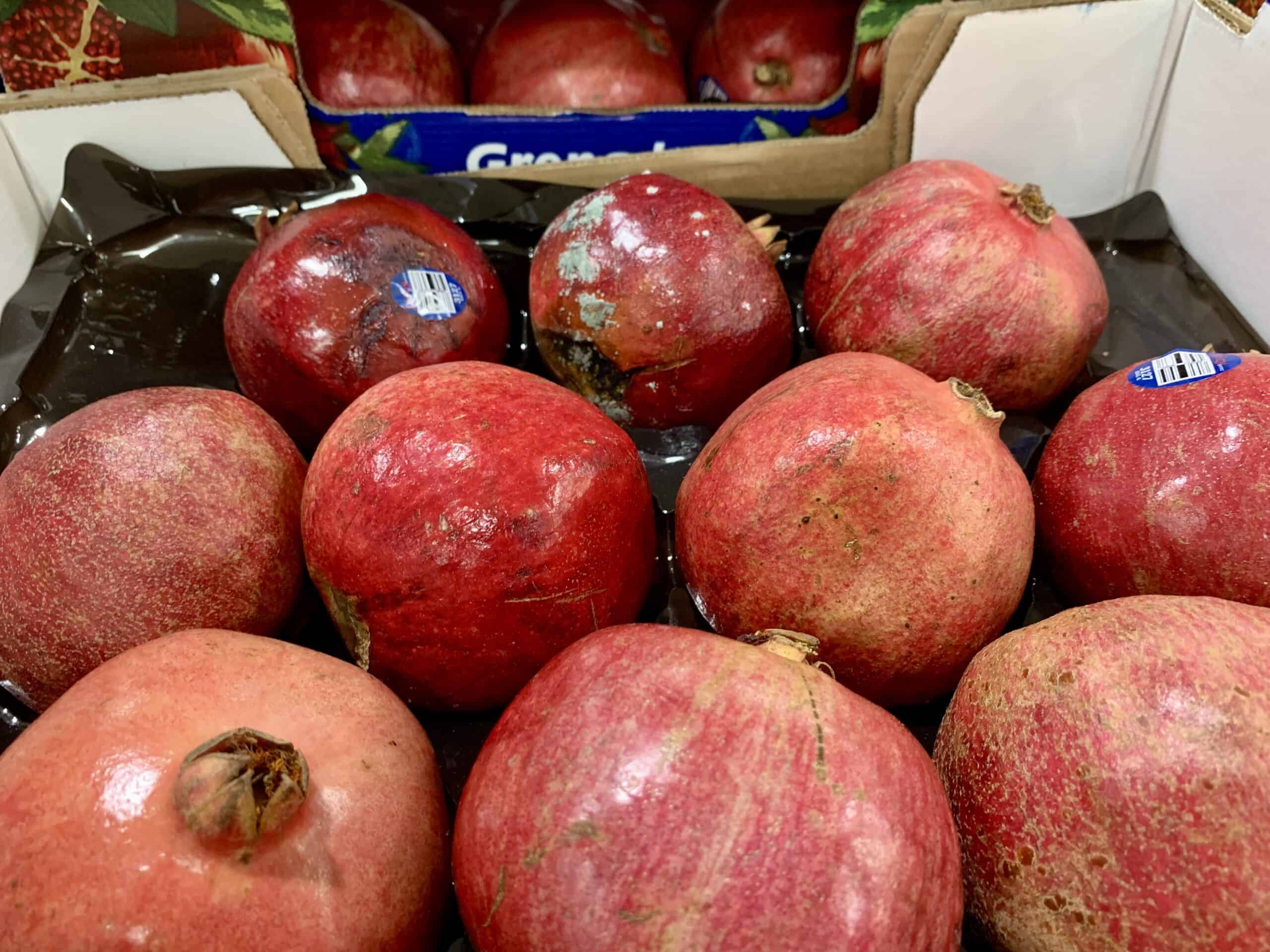
The fruits should have nice firm, leathery skin. It’s okay if you can press down a little bit but you shouldn’t be able to press down a lot.
When in season, I buy boxes of pomegranates from Costco. They usually come in boxes of nine. They are usually the Wonderful brand of pomegranates. Before buying, check them all to be sure they look good.
Once, when my son and I were on a pomegranate-kick, I bought two boxes at once. The pressure was on to eat 18 pomegranates before they went bad. (We kept them in the refrigerator to make them last longer.)
Note: Updating this in November 2023 to say my Costco now has boxes of 12 instead of 9. I’ve also bought jumbo pomegranates from my local Safeway grocery store. They were excellent.
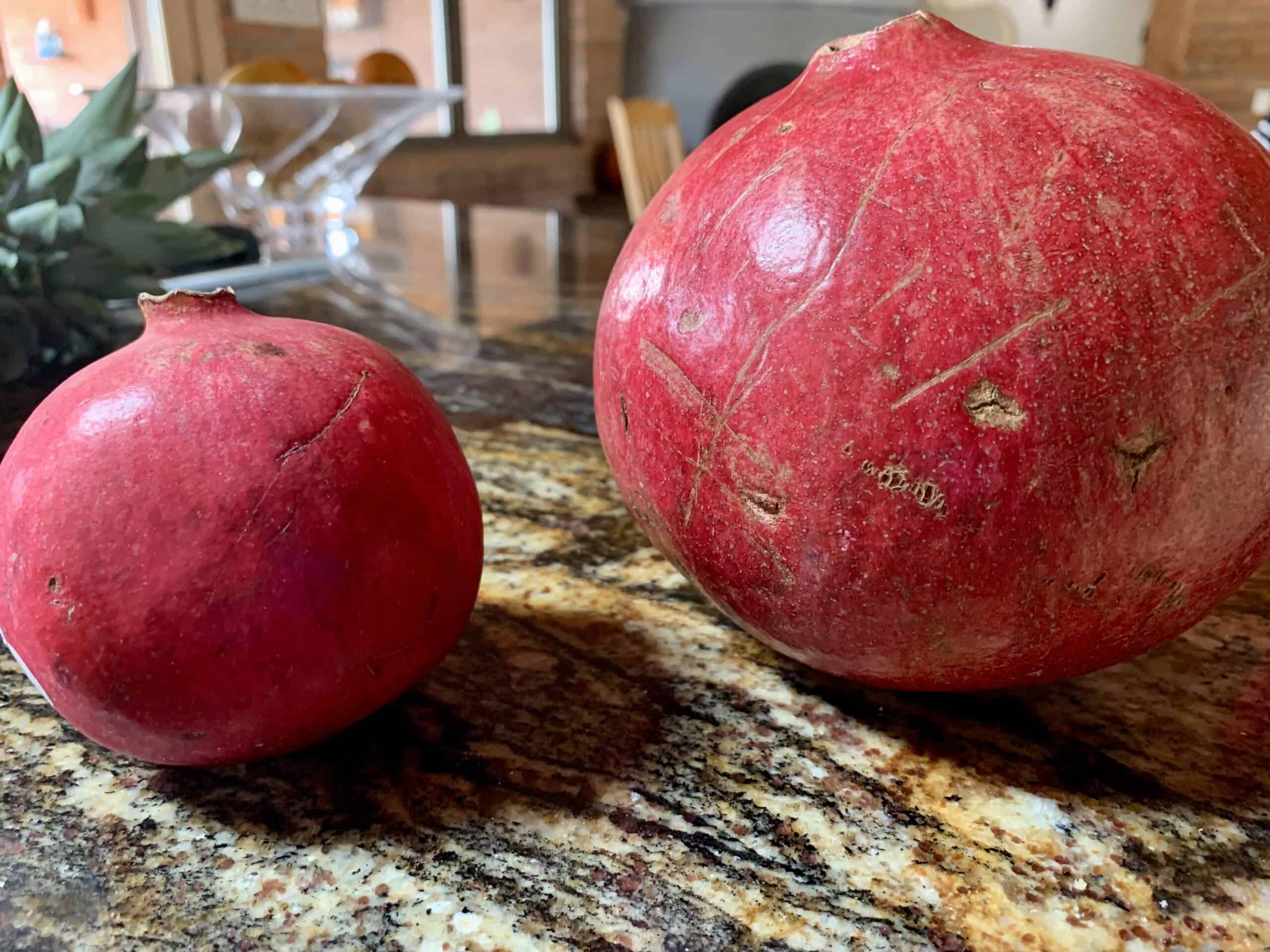
The great thing about buying them at the supermarket or farmers market is when you see them in abundance, they are in season. Chances are they are ripe. But you still want to be sure to pick the good ones.
Take your time to pick the best ones. This means picking ripe pomegranates that are ready to eat, but aren’t so ripe that the arils are getting moldy.
When buying them at the store in season (late fall and winter in the United States), there is a much greater chance of picking an overripe pomegranate versus an under-ripe pomegranate. However, if you see them out of season (I saw several at my local grocery store and at Costco at the beginning of June!) then there’s a chance they won’t be ripe.
When picking them from a tree, that’s when you need to worry about them being ripe and mature. If they are green, don’t pick them.
As someone grows pomegranates (I get a few every year from my three small trees) and buys them individually (from my local grocery store, Safeway, or from Walmart) and by the boxful (from Costco), I explain what to know about picking ripe pomegranates.
There’s nothing like cutting open a perfect pomegranate, full of sweet, juicy, and tangy arils. I think they are majestic and beautiful and taste amazing.
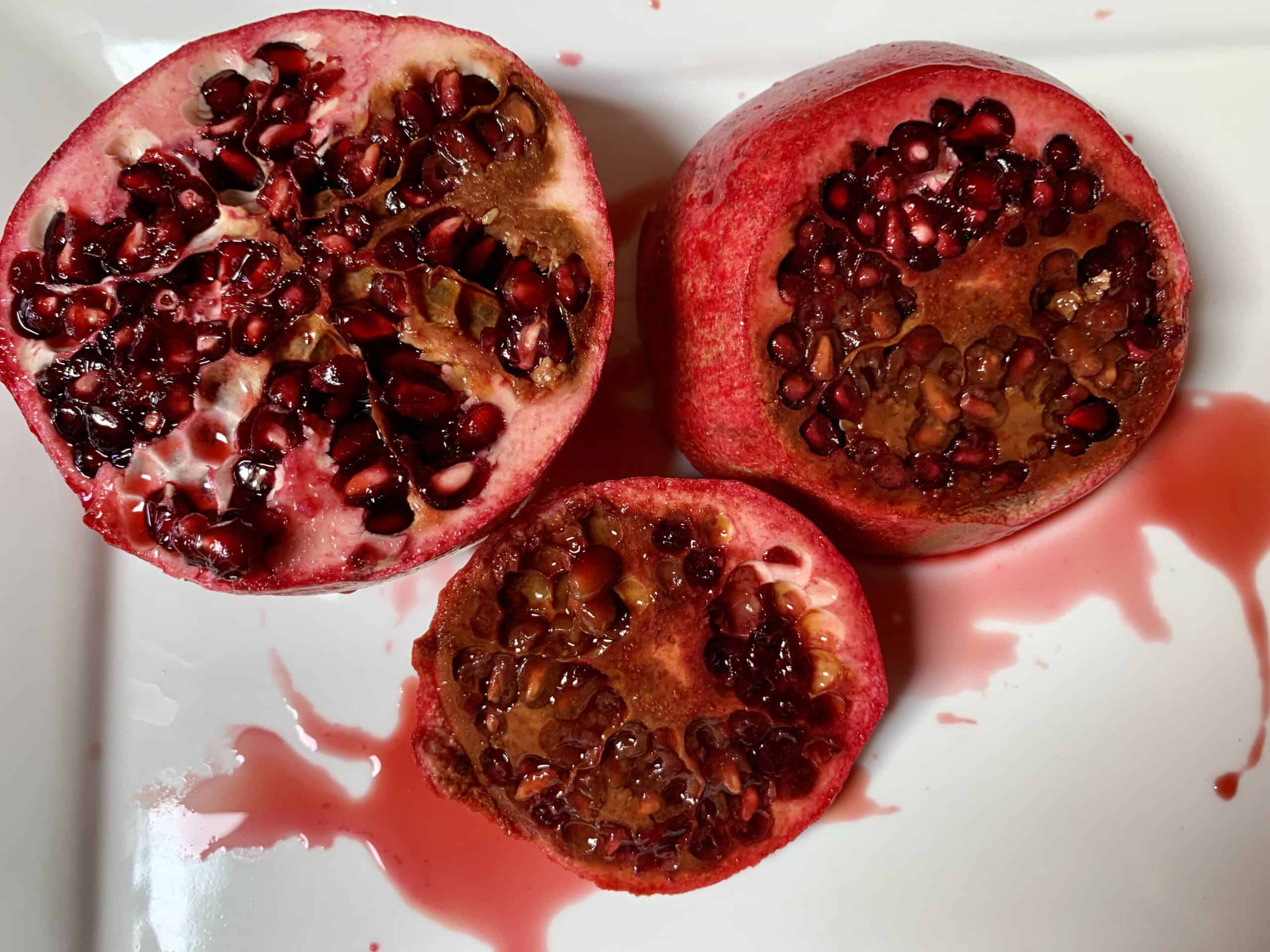
Choose Ripe, Not Overripe When Buying
Pomegranates ripen on the tree. Unlike many other fruits, pomegranates do not ripen after they are harvested. This means, if you are buying them from a store or farm stand, chances are they are red and already ripe. So rather than looking for ripe vs unripe, you need to be more concerned if they are ripe vs overripe.
When buying pomegranates, you want to be sure they aren’t overripe. There’s a small chance they will be under-ripe but that’s usually if you are buying them out of season.
Choose Ripe, Not Under-Ripe When Picking from a Tree
Because pomegranates ripen on the tree — not once they are on your countertop — you must harvest them when they are already ripe. Do not pick under-ripe pomegranates. Look for red, leathery skin. If they are green, don’t pick them.
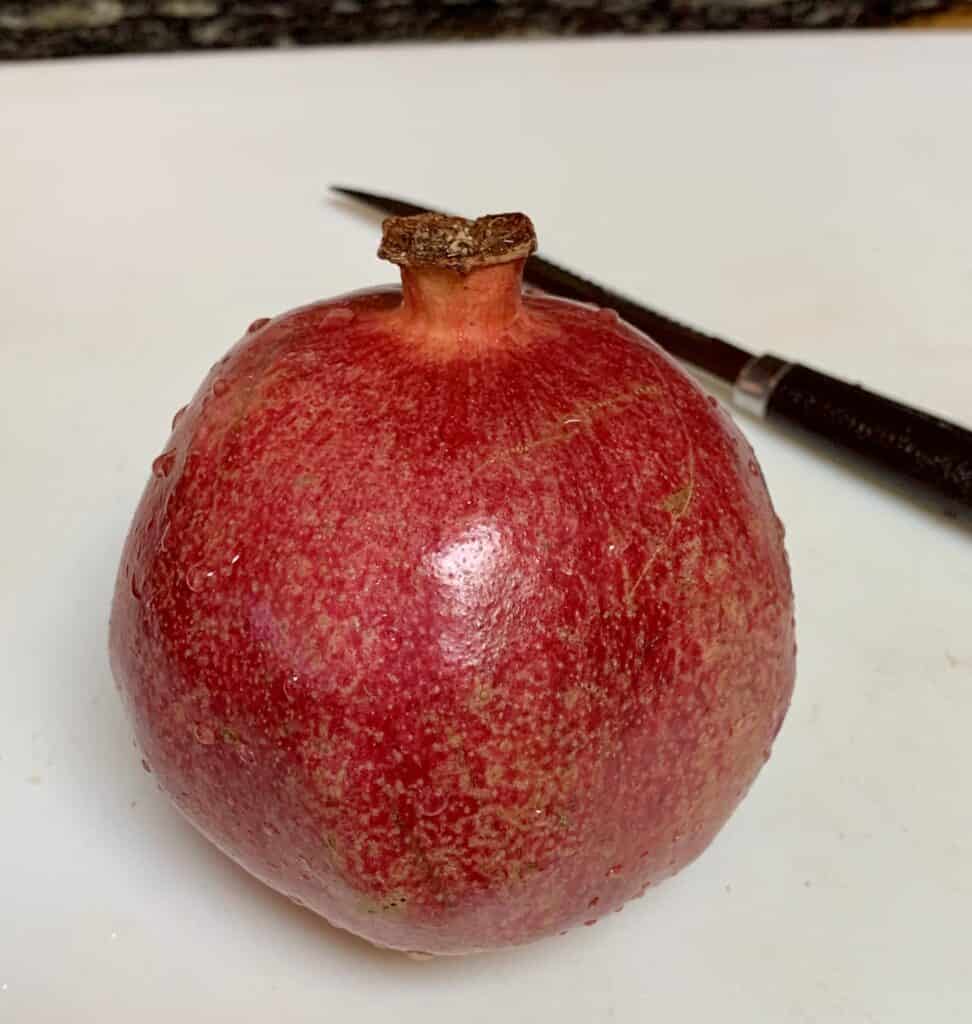
How to Tell if a Pomegranate is Ripe
Here are six ways to know when a pomegranate is ripe. They involve relying on your senses:
- Observe the color: Look for a deep, rich reddish-brown color, the telltale sign of a ripe pomegranate. Avoid green pomegranates which are not ripe. Look for all red and pink; it will depend on the variety.
- Check the weight: Ripe pomegranates feel heavy for their size due to the juicy arils inside.
- Look at the size and shape: The fruit should also be approximately the size of a very large orange. Ripe pomegranates tend to be round, plump, and slightly square in shape. When possible, choose pomegranates that look a little like boxy squares. If they look shriveled in any way, do not buy them.
- Feel the texture: The skin of a ripe pomegranate should be moderately hard and slightly rough to the touch. It should seem leathery and be easy to scratch. When picking from the store, don’t pick any with deep cuts or bruises. If harvesting from a pomegranate tree, pick any that are cracking open or splitting.
- Tap it: Just as you may knock on a watermelon to see if it’s hollow-sounding, you can tap on a pomegranate to determine if it’s ripe. It should sound a bit hollow and metallic when ripe. If it sounds like a dampened thump, choose another one.
- Press down: If it’s mushy, do not buy it.
By following these steps, you’ll know how to choose a pomegranate that’s ripe and ready to enjoy, whether from a tree or a store.
Note: Do not spend money on a pomegranate from the supermarket if it’s already cracking open. However, if the fruits are cracking open hanging from your tree, harvest them immediately. Enjoy them soon after picking so they don’t spoil.
How Pomegranates Ripen
If you want to learn more about how to know if a pomegranate is ripe, it’s helpful to understand a bit about the pomegranate’s biology. Its maturation and ripening process are unique. Understanding how they ripen can help you identify a ripe pomegranate.
Growth and Ripening Periods
Pomegranates grow on small, shrubby trees. The fruits typically reach their peak ripeness in the late fall. Fruits are ready to harvest around 6 – 7 months after flowers appear.
Timing can fluctuate a bit depending on the local climate and the specific pomegranate variety. In the United States, pomegranates usually ripen between September and December. Some ripen into January.
Ripening Process
Unlike many fruits, pomegranates do not ripen off the tree. This is crucial to remember when harvesting pomegranates or choosing them at the store. If a pomegranate isn’t ripe when you pick or buy it, it won’t become ripe. This means it’s important to know how to identify a ripe pomegranate at the moment of picking from a tree.
The Structure
A ripe pomegranate is a treasure trove of juicy arils: the edible seeds enclosed in a juicy red covering. These arils grow in small, compartmentalized clusters within the pomegranate, separated by a bitter, white membrane. The arils’ color, taste, and juiciness are key indicators of a pomegranate’s ripeness.
But looking at a pomegranate on the outside is how to determine if it’s ready on the inside.
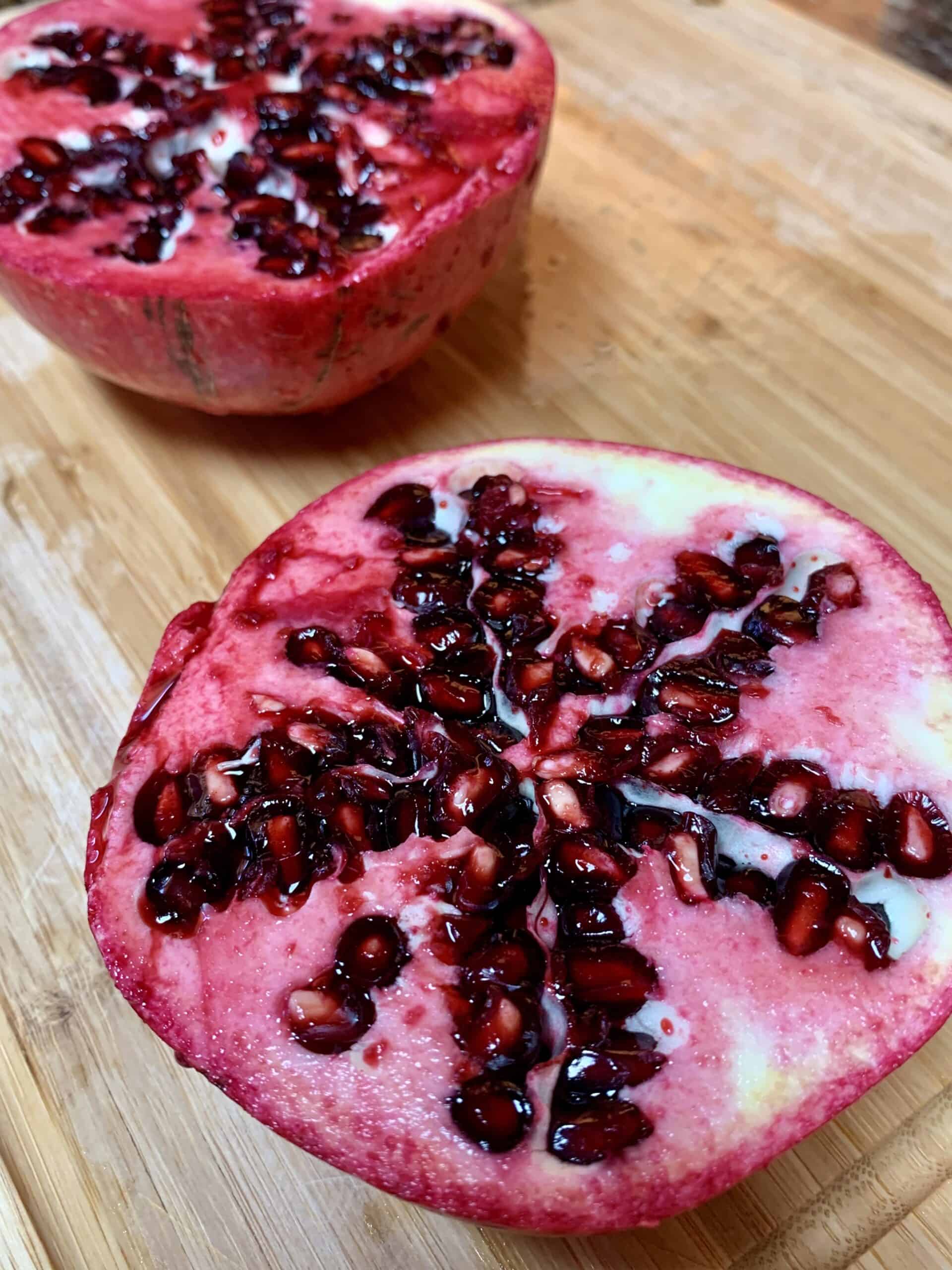
Ripe vs Unripe Pomegranate
An unripe pomegranate has a vibrant green color that gradually darkens to a red as it ripens on the tree. The skin is softer and the fruit lighter than its ripe counterpart. Knowing the difference between a ripe and unripe pomegranate is important so you get the most for your money at the grocery store and/or so you can have a good harvest.
It’s disappointing to wait all year for your pomegranates to grow and then pick them too early. Be patient. However, if possible, don’t wait for them to split and crack. By this time, it’s already starting to over-ripen. Also, insects could already be inside feasting on your fruits.
Picking a Ripe Pomegranate from a Tree
If you are lucky enough to be pomegranate-picking in your backyard or at an orchard, it’s important to know when a pomegranate ripe and ready for harvest.
Examine the color: Look for a deep red color. Do not pick green pomegranates.
Check the size: If the pomegranate is about the size of a large orange, it’s likely ripe.
Feel its weight without removing it from the tree: Gently cup a red pomegranate in your hand. If the pomegranate feels heavy, it indicates ripeness.
Look for cracks: Sometimes, ripe pomegranates crack open slightly, revealing their ruby-red arils. Harvest these soon so you can enjoy them.
Consider the timing: In the United States, pomegranate fruits are ready to harvest in the late fall and into winter, typically 6 or 7 months after they bloom. If you pick ripe pomegranates one year, note the dates for next year to get a better idea of when the variety you have is ready to harvest.
Learn about growing your own pomegranate tree.
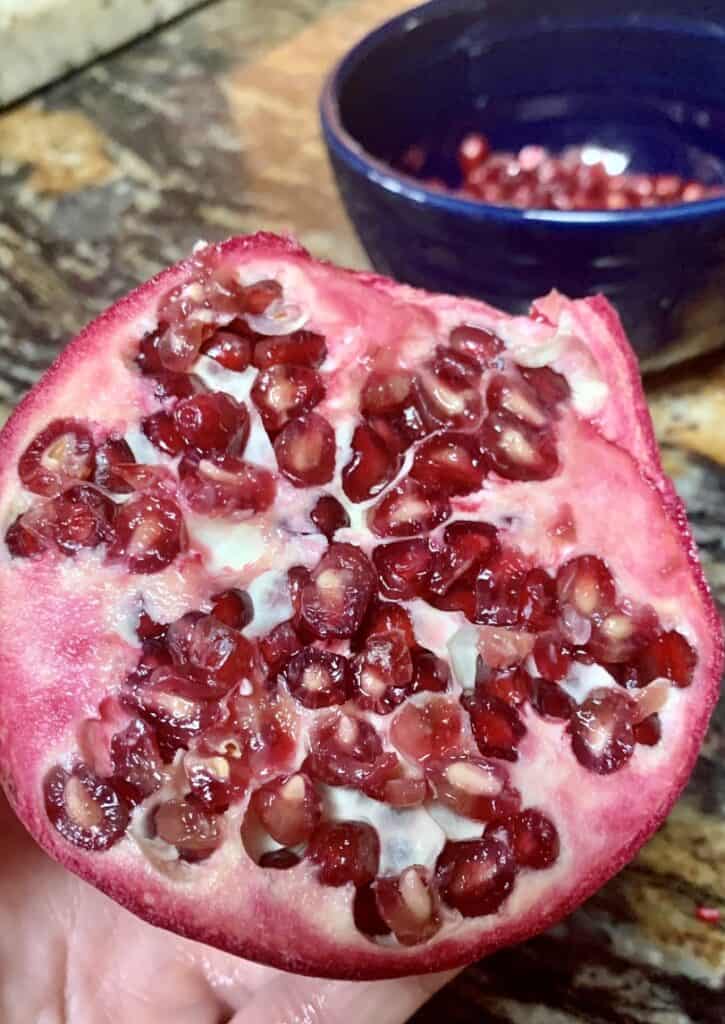
Post-Harvest Ripening
Do pomegranates ripen off the tree? No, pomegranates do not continue to ripen after being harvested. You have to know how to tell if pomegranate is ripe at the time of picking.
However, an already-ripe pomegranate will continue to ripen and will eventually spoil. So be sure to eat them ASAP so they don’t go to waste. You can refrigerate the whole fruits so they will last longer. Once you cut them, if you don’t eat them right away, cover them and refrigerate them for up to three days.
Choosing a Ripe Pomegranate at the Store
How to pick ripe pomegranates from a supermarket? Follow these steps:
- Look at the skin: A deep, uniform red color is a good sign. It should look like leather.
- Feel the weight: It should feel heavy for its size, indicating a juicy fruit.
- Check for blemishes: Avoid pomegranates with cuts, bruises, or mold.
- Gently press the skin: If it’s mushy, do not buy it.
- Examine the shape: Ripe pomegranates are round, plump, and have a slightly square shape. They should be the size of a large navel orange.
- Knock on it: If it sounds hollow or metallic, it’s a good sign that it’s ripe.
Buying Seasonal Pomegranates
If you’ve ever wondered how to know if a pomegranate is ripe when shopping, consider the seasonality. Purchasing seasonal fruits, including pomegranates, is one way to ensure freshness and optimal flavor.
The peak season for pomegranates in the United States runs from around October through January. When you buy pomegranates in the late fall and winter, you’re more likely to enjoy ripe, juicy fruits.
By purchasing pomegranates in their peak season, you’re stacking the odds in your favor. Whether you’re choosing a pomegranate from a tree or a store, let the season guide you toward the perfect pick.
The benefits of buying seasonal pomegranates are multifold:
Cost-Effective
Buying pomegranates in season can be more cost-effective. Since the supply is abundant, prices are often lower. You’ll be less likely to buy under-ripe or overripe fruit, saving you from potential disappointment and waste.
Prices do fluctuate. Costco will often mark their boxes down when they are becoming overripe. I will still buy them if I can find a box where all the fruits look good. (I change them out from other boxes). Be sure to refrigerate them when you get home.
I came here to update this post (mid-December 2023) to say my Safeway was selling regular-sized pomegranates for $2.50, and now this week they are $2 each. When in stock, my Safeway has been selling the jumbo pomegranates for $5 each.
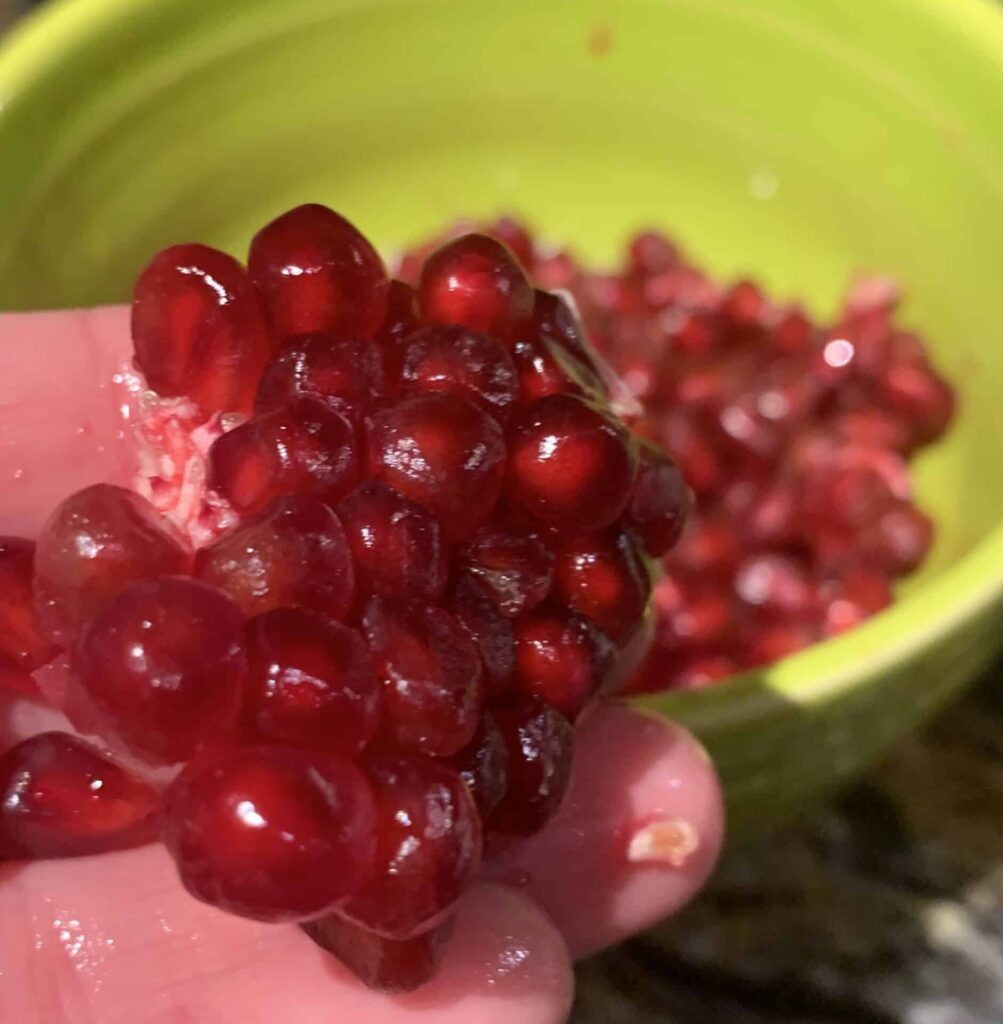
Peak Flavor
Buying fruits in season means there is a better chance they will be at their peak ripeness and flavor.
Pomegranates harvested in season have had adequate time to ripen naturally on the tree, helping to ensure they’re bursting with sweet and tangy juicy arils.
Environmental Impact
Buying seasonal fruit contributes to reducing the carbon footprint since the fruits are usually locally sourced and do not require long-haul transport. Most of the pomegranates grown commercially in the United States are grown in California.
Supporting Local Economy
When you buy seasonal, you’re often buying local. This support helps local farmers and contributes to the community’s economic health. When in season, all the pomegranates in stores near my home were grown in California.
The pomegranates I saw out of season (in the US) had stickers that said they were grown in Peru.
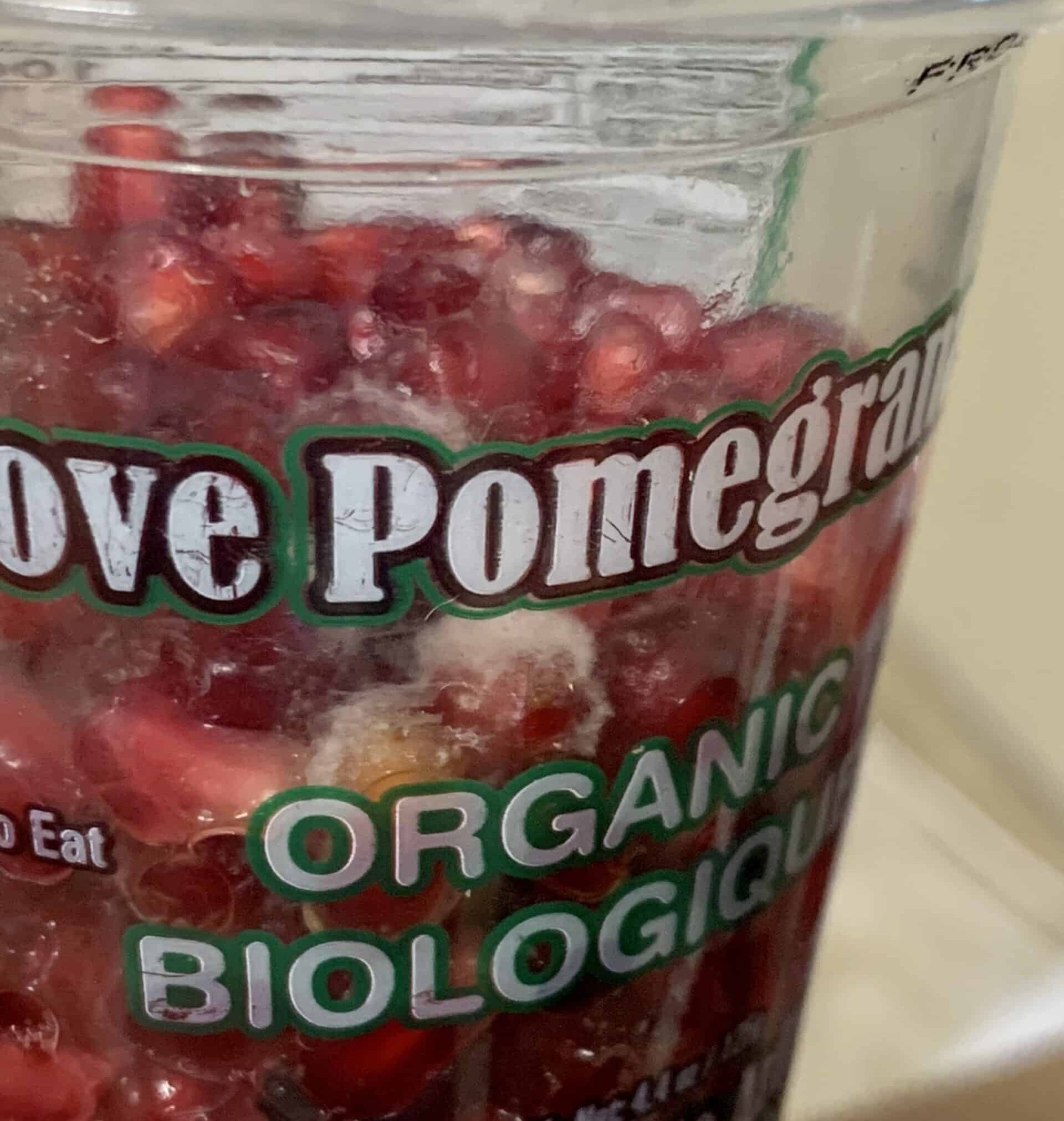
Pomegranate Season
The arrival of pomegranate season is typically from October through January in the United States. During these months, supermarkets and farmers’ markets abound with pomegranates at their peak ripeness.
I love putting out cut pomegranates on charcuterie boards for winter gatherings. They up the visual appeal and presentation factor with their uniqueness and vibrant colors. Plus they are a bit more upscale-seeming than only serving cheese, crackers, grapes, etc.
The crimson and deep-red exteriors of these seasonal gems add a splash of color to the display and also a mix of sweetness and tang from the arils.
Whether you’re selecting your fruit from the neatly stacked displays of a grocery store, from a local farmers’ market, or harvesting them from you own tree, knowing how to tell if a pomegranate is ripe means you will choose the best ones.
Enjoy the bounty of the season by choosing pomegranates that are heavy for their size and free from blemishes.
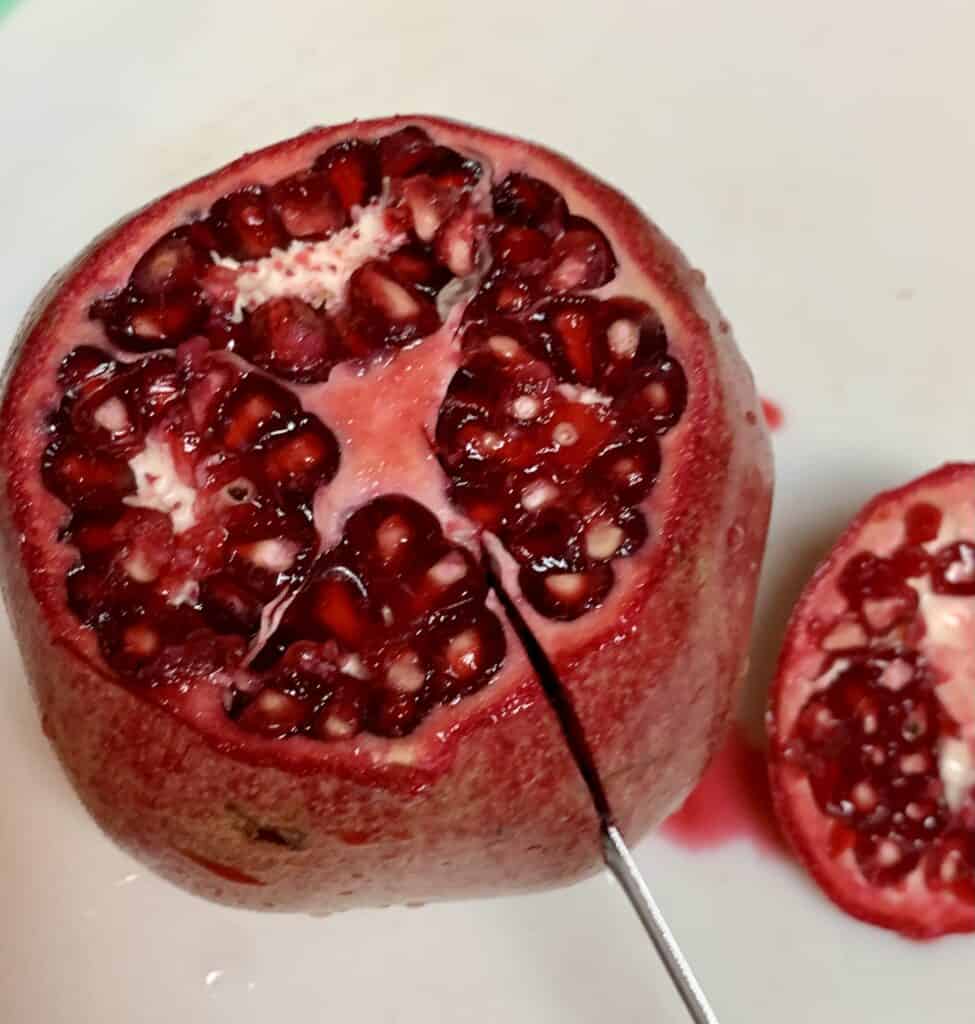
Overripe Pomegranate
An overripe pomegranate will have skin is often shriveled and feels softer than usual. If it’s soft or mushy, do not buy it. The color may have patches of brown or appear overly dark. It may feel lighter than expected, as the arils inside could have started drying out.
Furthermore, overripe pomegranates may develop mold, especially around the stem area or in cracks in the skin.
Under-Ripe Pomegranate
An under-ripe pomegranate’s skin is usually a lighter shade of red or even green, rather than the deep red of ripe ones. It tends to feel lighter in weight due to the lack of juicy arils inside.
The skin of under-ripe pomegranates can also feel harder and “less yielding” than that ripe ones. When you tap it, will won’t have that metallic sound.
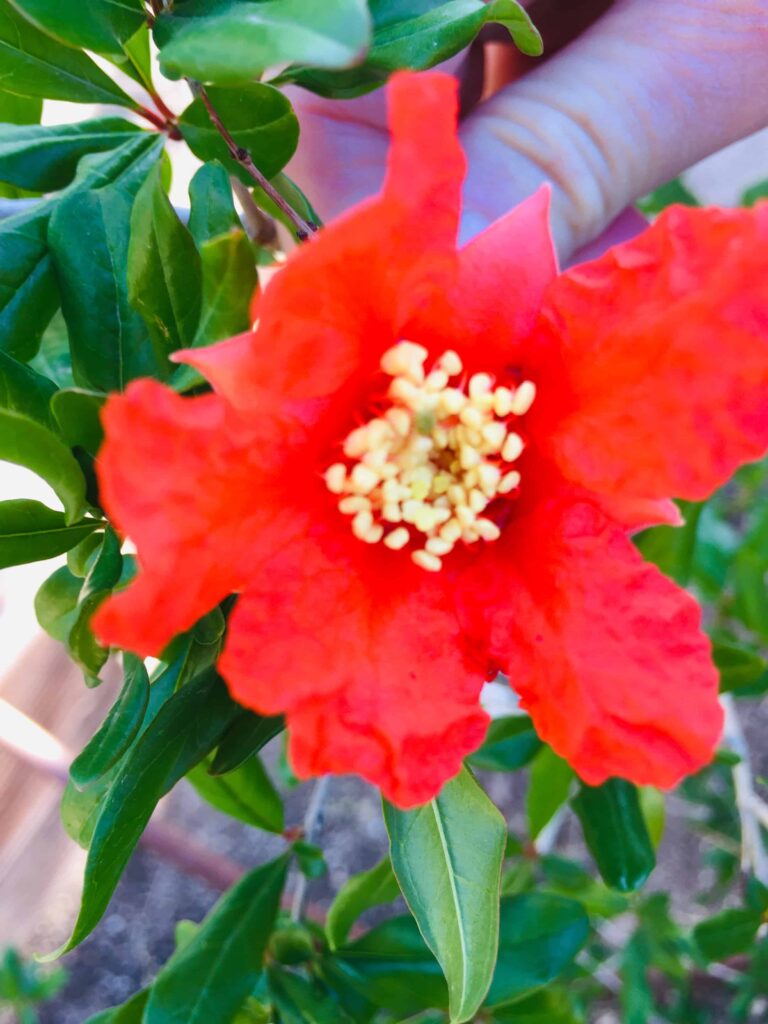
When to Pick Pomegranates
Pomegranates are usually ready to be picked in the late fall, although the timing will vary based on your local climate and the variety you are growing. A ripe pomegranate is ready to pick when: it’s a deep red color, feels heavy for its size, and is approximately the size of a large orange.
Sometimes, ripe pomegranates even slightly crack open on the tree. When this happens, you may be able to see the jewel-like arils.
Remember, once harvested, pomegranates do not become mature. Be sure they have reached full maturity before picking.
However, already-ripe pomegranates will eventually become overripe once picked from the tree or after you buy them from the store. Like all fruit, they will eventually go bad or “go off”.
Types of Pomegranates and Their Ripeness Indicators
Pomegranates come in several varieties, each with distinct traits that can influence their appearance when ripe, under ripe, or overripe. Recognizing the specific characteristics of each variety aids in understanding how to know if a pomegranate is ripe, regardless of the type.
Wonderful
This is maybe the most popular variety of pomegranate in the United States. You will often see the brand “Pom Wonderful” in the store.
When ripe, the Wonderful pomegranate has a bright to dark red outer skin. If under-ripe, the skin can be pink or partly green, and if overripe, it may start to show wrinkles or dark spots.
Angel Red
This variety is known for its dark red exterior and large arils. A ripe Angel Red pomegranate will have a deep, almost crimson color. An underripe fruit may still have patches of green, while an overripe one might exhibit wrinkles and softened skin.
Granada
A ripe Granada pomegranate will have a glossy, bright red skin. If underripe, it tends to be lighter in color, while overripe fruits develop a dull skin with brownish spots.
Parfianka
Parfianka pomegranates are praised for their rich flavor. When ripe, they possess a red to slightly pinkish-red skin. If underripe, the skin may be more pink than red. Overripe Parfianka pomegranates may have dull, wrinkled skin.
How to Store Pomegranates
Storage plays an important role in maintaining the quality of your pomegranates. Once ripe, you can store whole pomegranates at room temperature for about a week.
For longer storage, place them in the refrigerator, where they may (or may not!) last up to two months. How long you can store pomegranates is dependent on how ripe they are when you buy or harvest them. If they are already overripe, they won’t last as long.
Once you cut the pomegranate and remove the arils (deseed the pomegranate), it won’t last as long. You can store the arils in an airtight container in the refrigerator for up to 3 days (sometimes 5 days), or frozen for several months.
If you cut a pomegranate in half, and use only one half, you can refrigerate the other half. Put it in an airtight container, seal it with plastic wrap, or put it in a plastic bag (squeeze out as much air as you can). It should last 3 – 5 days.
FAQs
How to tell if a pomegranate is ripe?
To determine the ripeness of a pomegranate, you can check for a deep, red exterior color, a size comparable to a large orange (but should be boxy, not circular), and a moderately hard texture. A ripe pomegranate will also feel heavy for its size due to the juicy arils inside.
How do you know if a pomegranate is ripe on the tree?
When the fruit is still on the tree, it’s ripe when it has a deep red color, is about the size of a large orange, feels heavy, and possibly even cracks open slightly, revealing its ruby-red arils.
How to know if pomegranate is ripe at the grocery store?
In a grocery store, a ripe pomegranate should have a deep, uniform red color and feel heavy for its size. Avoid pomegranates that are soft or mushy and those with blemishes, such as cuts or bruises.
Choose pomegranates that are round, plump, and slightly square-shaped. Buying them in the fall and winter, aka pomegranate season in the United States, will also help ensure they are ripe.
Do pomegranates ripen after being picked?
No, pomegranates do not continue to ripen after being picked. That’s why it’s important to know how to tell if a pomegranate is ripe before harvesting it.
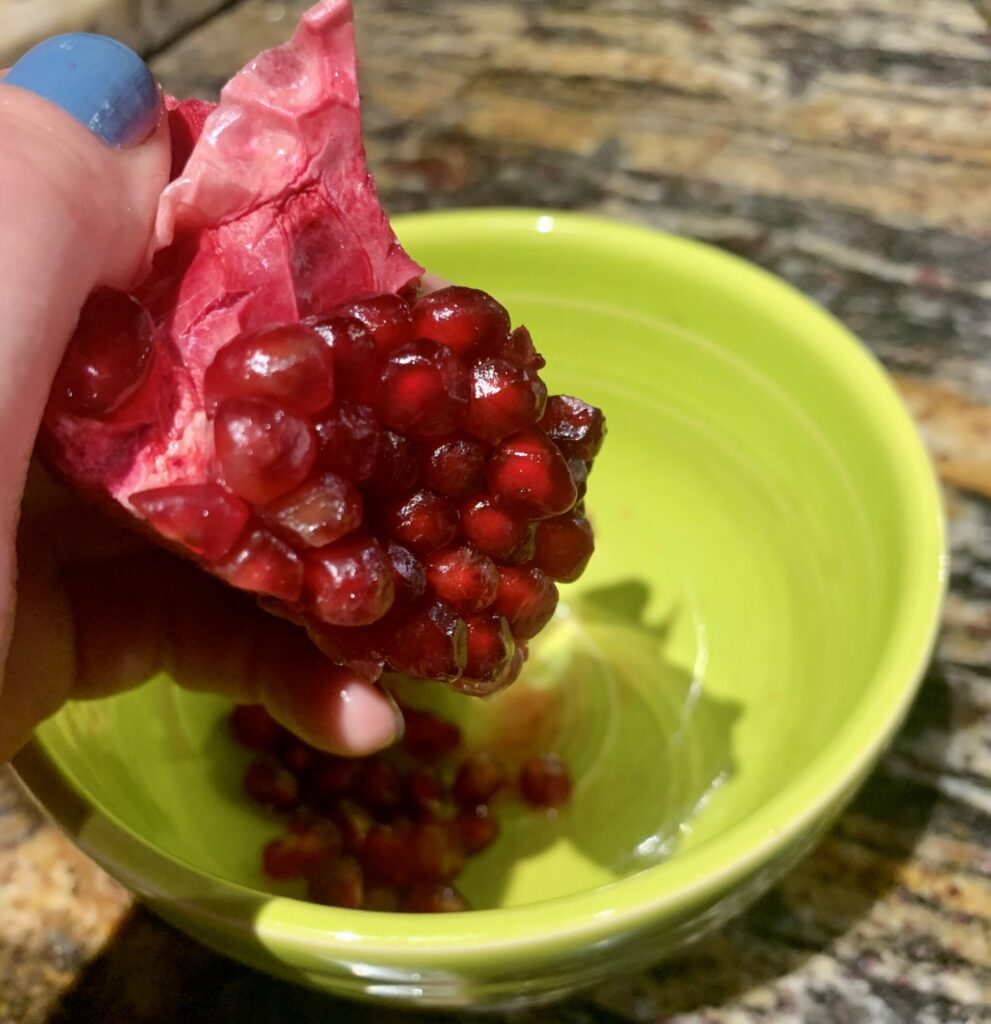
How can I tell the difference between a ripe vs unripe pomegranate?
A ripe pomegranate typically has a deep red to reddish-brown exterior, is heavy for its size, and has a moderately hard, leathery skin. An unripe pomegranate will be green and light with soft skin.
When to pick pomegranates from the tree?
In the United States, pomegranates are usually ready to harvest from October through January, depending on the climate and variety. If you grow pomegranate trees, look for the blooms. The fruits are typically mature and ready to pick about 6 or 7 months after they flower.
Pick pomegranates from your tree when they are deep red, are about the size of a large orange, and feel heavy. Sometimes, ripe pomegranates may crack open slightly.
When is a pomegranate ripe to eat?
A pomegranate is ripe and ready to eat when its exterior color is deep red, the fruit is heavy for its size, and the skin is moderately hard. The pomegranate skin should look like leather. If you tap it, it should make a metallic sound.
What happens if you eat an unripe pomegranate?
Unripe pomegranates can be very sour compared to ripe ones, which are sweet and tangy. The arils will be pink or lighter red.
Do you need to refrigerate pomegranate seeds?
Yes, you need to refrigerate pomegranate seeds whether you remove them from a fresh pomegranate or you buy the seeds in cups on their own. Before buying the cups, look at the bottom to be sure none are moldy.
Should you store pomegranate seeds?
You can store pomegranate seeds in the refrigerator for 3 – 5 days. Be sure they are completely covered. The times you should not store pomegranate seeds are if you removed them from an overripe pomegranate. You should consume them sooner rather than later so they don’t spoil.
Do you eat the middle of pomegranate seeds?
Yes, you can eat the middle of pomegranate seeds though they are harder than the juicy exterior.
Are you supposed to eat the pomegranate seeds or just the juice?
The edible fruit of the pomegranate are the seeds. They are juicy with an edible but harder center. You can also extract the juice from the seeds if you prefer. The seeds are called arils.
What is the difference between pomegranate seeds and arils?
Pomegranate seeds and arils are the same thing. They are the crimson juicy jewels you remove from pomegranates and eat. You can spoon them out or pick them apart.
Conclusion
Pomegranates are delicious when in season. But how do you know when a pomegranate is ripe and ready to eat? Check it’s color, heaviness, sound, skin, and shape.
Learning how to tell if a pomegranate is ripe means you will be able to enjoy this fruit at its best. I think pomegranates are wonderful, and as I mentioned above, I buy them often when they are available in season. I know I will have to wait another 9 – 10 months before enjoying them again, so I buy them whenever I can.
I hope you will use this information on how to know if pomegranate is ripe, how to tell if a pomegranate is ripe from a tree, and how to pick ripe pomegranates at the store. So the next time you’re in the produce section and see a bin with pomegranates, you’ll know which ones to choose.
Knowing how to pick the best pomegranates will help you not waste money by buying pomegranates that aren’t ripe or are overripe.
Whether you’re picking them from a tree or from your local supermarket, remember the deep red color, the plump, boxy shape, and the weight are your key indicators of a ripe pomegranate.
The featured image with a box of pomegranates… this is the time I bought two boxes (18 pomegranates) from Costco! Image credit: Dawn Head
Reference: About Punica granatum

